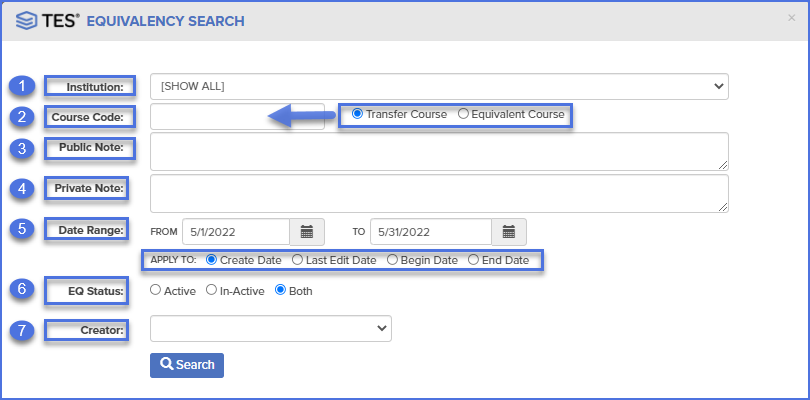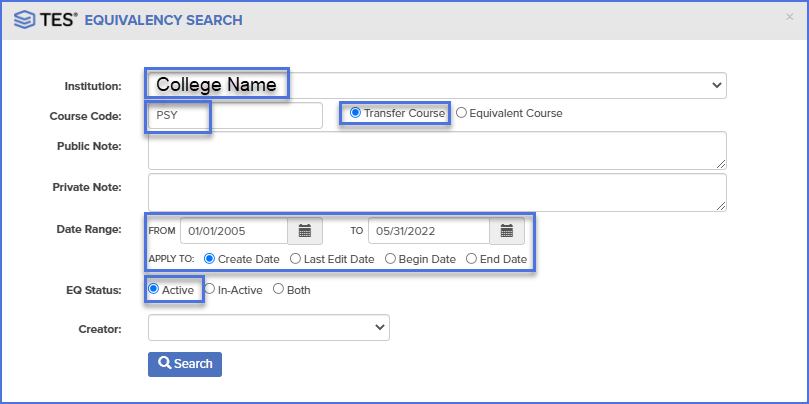Finding Equivalencies through the Equivalency Search
Equivalency Search is a feature within the Equivalency Batch Editor whereby equivalencies can be located. These equivalencies can then be exported, batch edited, or batch deleted. In this article, the following will be reviewed:
Start by navigating to the Match menu and selecting Equivalency Batch Editor. Then, select EQ Search:

Search Criteria
Once EQ Search is selected, the Equivalency Search screen appears. The below search criteria can be adjusted to help locate the equivalencies one may be looking to view, export, batch edit, or batch delete.

1. Institution:
Select the institution name from the drop-down list to search for equivalencies to coursework at a particular school. Otherwise, [SHOW ALL] will display equivalencies from all institutions.
2. Course Code:
Search by either Transfer Course or Equivalent Course (your institution's course).
- Enter either the entire course code (ex. ENGL1475) or enter a partial course code.
- For example, if one were looking to find all courses with equivalencies to coursework within their school's English department, they could search by just the subject (ENGL).
3. Public Note:
To find equivalencies that contain a particular public note, input that text in the search box. The search will locate all equivalencies that contain that text, so the returned results may include more than just the text entered. The less entered, the more results will appear. The more you enter, the fewer results will be produced.
4. Private Note:
To locate equivalencies that contain a particular private note, enter the text in the search box. Any equivalency that contains that text will appear in the search results. Again, the less entered, the more results will appear.
5. Date Range:
Searches can be performed across a range of dates or one particular date. Manually enter the date(s) searching across in the FROM and TO fields, or use the calendar icon to select these. Then choose whether the Date Range applies to the Create Date, Last Edit Date, Begin Date, or End Date by selecting the corresponding radio button.
- If searching by one particular date (example: find all equivalencies with an End Date of 8/31/2022) enter the date into both the FROM and TO fields.
- Date Range is a required field and will need to entered in each search:
- If performing a search for equivalencies across any Date Range, it's recommended that you use 1/1/2005 as the FROM Create Date, as TES was introduced in March of 2005. The TO date default (the last day of the current month) would not need adjustment..
6. EQ Status
Use this field to search for:
- Active equivalencies
- In-Active equivalencies
- Both Active and In-Active equivalencies
An equivalency is considered In-Active if its Start Date hasn't yet begun or its End Date has passed.
7. Creator
Search for the user who created the equivalency by selecting their name from the drop-down list.
Search Results
Once search criteria have been defined, select Search.
The below example illustrates the criteria needed to find all active equivalencies to CollegeSource University's COMM103.
- the Institution default of [SHOW ALL] is used to locate equivalencies CollegeSource University has with any transfer school.
- COMM103 is entered into the Course Code field.
- Equivalent Course has been selected, as CollegeSource University is the home institution.
- Since Public Note, Private Note, and Creator are not relevant to the search, these fields are left blank.
- A FROM and TO date are required to be entered.
- Since this search is looking for all active equivalencies, the Create Date of 1/1/2005 was chosen - this was the year that TES was introduced, so no equivalencies could have been created before that time. This search is being performed in May of 2022, so the default TO date is not adjusted.
- The Active EQ Status button is selected.

All Active equivalencies between the date range noted are displayed:

Once search results are made available, they can be batch edited, deleted, or exported to Word or Excel. A maximum of 2,000 results can be updated, deleted, or exported at once. See the Related Articles below, which will detail how to perform these actions.
Use Case Scenarios:
The Equivalency Search is a powerful tool that can locate, edit, and report on equivalency data. Below are some examples of when institutions might use this feature:
Curriculum Changes
Equivalency Search can locate equivalencies that need maintenance due to curriculum changes.
For example, if a school's first-year writing course underwent a description change, they could perform a search to locate and end-date all equivalencies. They would not have to individually end-date hundreds of equivalencies!
- Additionally, the Health Check Reports within the Equivalency Batch Editor also have tools to help maintain equivalencies.
Data Reporting
TES can help institutions report information about their transfer equivalencies to stakeholders on their campus. Equivalency Search enables users to find and export this data and share it in an easily-understood format. When using the Equivalency Search to find data, it's essential to ensure that all parties have a clear picture of the question they are trying to answer, as this will influence the needed search criteria.
Suppose that a school's Psychology Department Head is interested in seeing how Psychology courses transfer from their local community college currently transfer. To find all active equivalencies within that school's Psychology course code (PSY), the below search criteria would be used:
- the community college name is selected from the Institution drop-down list.
- The institution's Psychology course subject is PSY. Since the query is looking to find all active equivalencies within the subject transfer, a partial course code is used.
- Transfer Course has been selected.
- Since Public Note, Private Note, and Creator are not relevant to the search, these fields are left blank.
- A FROM and TO date are required to be entered.
- Since this search is looking for all active equivalencies, the Create Date of 1/1/2005 was chosen, and the TO default is left as is.
- The Active EQ Status button is selected.
Note that if the Psychology Department Head was interested in seeing how courses from their local community college currently transfer into the Psychology department, that would be a different search. In that example, the home institution would need to enter their Psychology course code in the Course Code field, and select Equivalent Course.
